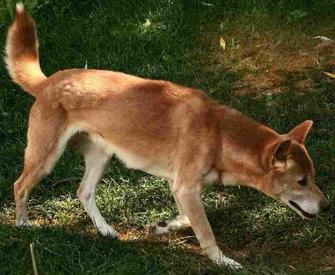
A unique and elusive breed, the New Guinea Singing Dog is known by various names, including the New Guinea Dingo or Wild Dog, the Hallstrom Dog or the Bush Dingo. The exact history of the breed is uncertain, although it is widely accepted that the New Guinea Singing Dog dates back to the Stone Age or pre-Neolithic times roughly 10,000 years ago. It is likely that the breed descends from ancient wolves or from dogs taken through China to New Guinea, being domesticated along the way. Precious little is known beyond this speculation due to the rarity of the breed; initially declared a unique species, later to be classified a 'feral dog,' the earliest recording of a New Guinea Singing Dog leaving its native land was in 1897, with its skeletal remains being transported to the Queensland Museum.
Genetic evidence links the breed with the Australian Dingo, a dog comparable in size and structure. With a fox-like appearance, the New Guinea Singing Dog boasts muscular legs, a broad head, triangular ears, a high, plumed tail with heavy feathering and ovular eyes. The dense coat is typically a moderate length and usually coloured solid red or red with white markings, or else black and tan. The bushy tail makes the breed easily mistaken for a fox. The most distinctive quality of the New Guinea Singing Dog is found in its name, being the only breed in possession of a harmonious, undulating tone that is unmatched by even the most beautiful sound of the hounds. On many occasions, the New Guinea Singing Dog has faced near extinction, remaining one of the world's rarest breeds today.
Few of these dogs are seen in the domestic setting, although some have been carefully bred by enthusiasts. Traditionally, the majority of New Guinea Singing Dogs in existence were found in zoos, although since its re-classification as a domestic dog subspecies, the breed is no longer so numerous in this setting. Those fortunate enough to own a New Guinea Singing Dog have described it as aloof but highly affectionate when socialised from puppyhood, shown firm leadership and consistently trained. Due to its inherent wild nature, the breed is not particularly adaptable, rendering it unsuited to certain homes and owners. Generally, a New Guinea Singing Dog will weigh 8-14 kg, with a long life expectancy of roughly 15-20 years.
Commonly thought of as a hardy and long-lived breed, little is known of any genetic or breed-specific diseases because of the rarity of the New Guinea Singing Dog.
Do you own a New Guinea Singing Dog? Let others know what they're like!
Related products
Advantage 80 Spot On Flea Control Large Cats and Rabbits
from £12.95
Advantage 40 Spot On Flea Control Cats, Small Dogs and Rabbits
from £12.95
Advantage 100 Spot On Flea Control Medium Dog
from £12.95
Advantage 250 Spot On Flea Control Large Dog
from £12.95
Drontal Tasty Bone Wormer Tablets for Small & Medium Dogs (2 to 20kg)
from £2.15
FRONTLINE Plus Flea & Tick Treatment Dogs & Cats
from £17.49
TermaWorm™ Tablets for Cats & Dogs
from £1.59
Drontal Tasty Bone XL Wormer Tablets for Large Dogs (Over 20kg)
from £6.39